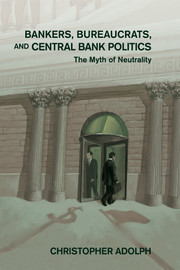Book contents
- Frontmatter
- Contents
- List of figures
- List of tables
- List of boxes
- Abbreviations
- Acknowledgements
- 1 Agents, institutions, and the political economy of performance
- 2 Career theories of monetary policy
- 3 Central banker careers and inflation in industrial democracies
- 4 Careers and the monetary policy process: Three mechanism tests
- 5 Careers and inflation in developing countries
- 6 How central bankers use their independence
- 7 Partisan governments, labor unions, and monetary policy
- 8 The politics of central banker appointment
- 9 The politics of central banker tenure
- 10 Conclusion: The dilemma of discretion
- References and Author index
- Subject index
- About the type, figures, and data
- Other Books in the Series
6 - How central bankers use their independence
Published online by Cambridge University Press: 05 April 2013
- Frontmatter
- Contents
- List of figures
- List of tables
- List of boxes
- Abbreviations
- Acknowledgements
- 1 Agents, institutions, and the political economy of performance
- 2 Career theories of monetary policy
- 3 Central banker careers and inflation in industrial democracies
- 4 Careers and the monetary policy process: Three mechanism tests
- 5 Careers and inflation in developing countries
- 6 How central bankers use their independence
- 7 Partisan governments, labor unions, and monetary policy
- 8 The politics of central banker appointment
- 9 The politics of central banker tenure
- 10 Conclusion: The dilemma of discretion
- References and Author index
- Subject index
- About the type, figures, and data
- Other Books in the Series
Summary
Bernard WOOLLEY, Principal Private Secretary to the Minister for Administrative Affairs: That's how the civil service works in practice – each department is controlled by the people it's supposed to be controlling. … Every department acts for the powerful sectional interest with whom they have a permanent relationship.
Jim HACKER, Minister of the Department of Administrative Affairs: So the whole system is designed to stop the cabinet from carrying out its policies?
WOOLLEY: Well, somebody's got to.
HACKER: But shouldn't the civil service be committed to helping the government carry out its wishes?
WOOLLEY: So it is, as long as the government's wishes are practical.
HACKER: Meaning?
WOOLLEY: As long as the civil service agrees with them.
“THE BED OF NAILS,” Yes MinisterTHE CAREER THERORY of central banker motivations lets us revisit old questions and gain new insights. An important example is the debate among Iversen (1999), Hall and Franzese (1998), and Cukierman and Lippi (1999), who explore the interactive effects of central banks and labor unions on economic performance. This intriguing literature emerged from the insight that if unions have any wage-setting power, then central bankers have the ability to shape the real economy using monetary policy, even over the long run. Yet to date, this work lacks any way to measure a concept at its theoretical core: the conservatism of the central bank. In this chapter, I combine measures of central bank autonomy and conservatism into a new measure of overall central bank nonaccommodation.
- Type
- Chapter
- Information
- Bankers, Bureaucrats, and Central Bank PoliticsThe Myth of Neutrality, pp. 182 - 204Publisher: Cambridge University PressPrint publication year: 2013



